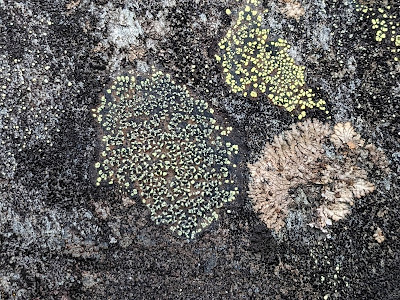During our trip to Alaska, my Aunt Char and I visited Mendenhall Glacier with my brother, Dave and sister-in-law, Karen (see Alaska - The Last Frontier). I was curious about what species of lichen we would see so close to the glacier. I've been observing the lichen in our yard in the San Francisco Bay Area (see Portraits in Lichen and More Portraits in Lichen). How would they compare with lichen in a colder and wetter environment?
 |
| Map lichen (Rhizocarpon geographicum) the yellow thalli Per iNaturalist, the pinkish organism to the right is a fungus (Anaptychia runcinata) |
 |
| Orange lichen (Caloplaca spp.) |
Some of the area around the glacier had been covered by ice over the last one or two hundred years while the glacier receded, so the exposed land is relatively "new" and lichen is slow growing. While pondering all of this and taking pictures of lichen, a stranger at the glacier humorously informed me that I was photographing a rock. Sigh. The mysteries of the universe were lost on him.
 |
| Orange boulder lichen detail (Porpidia flavocaerulescens) |
 |
| Orange boulder lichen in community |
I'm expanding my lichen vocabulary a bit, using the glossary in Casselman's Lichen Dyes: The New Source Book. Knowing a few terms can help you describe what you are seeing, and then find out more information. Some basics:
- apothecia - cusp-shaped disks on the upper cortex of the lichen that contain asci (spores).
- cortex - either surface of a lichen (top: dorsal or upper cortex; bottom: ventral or lower cortex).
- substrate - surface to which a lichen is attached, such as a rock or a tree.
- thallus - the entire lichen (plural "thalli").
These white lichens stand out against the dark granite boulders, but are difficult to identify. It is surprising how many species are growing together in communities over the glacial boulders.
 |
| Tile lichen (Lecidea tessellata) |
 |
| White rim lichen (Lecanora rupicola) |
After spending time with lichen in both the Bay Area and Juneau, Alaska, I think I need to get closer with a magnifying hand lens! Still, I had fun trying to identify the species we encountered.
Learn More:
- Alaska.org - a travel website dedicated to Alaska. Check out the resources, and search for "lichens" to learn more about the lichen species in Alaska (https://www.alaska.org/search?query=lichens).
- Lichens around Mendenhall Glacier, by Chiska C. Derr and Robert H. Armstrong. Nature Alaska Images, Juneau, Alaska, 2010. The authors describe what lichen is and is not, habitats, lifecycle, and how to identify them. I especially liked their quote from lichenologist Trevor Goward, “lichens are fungi that have taken up agriculture”. I was intrigued to learn that lichens that contain cyanobacteria are nitrogen fixers, so important for soil development.
- Lichen Dyes: The New Source Book, by Karen Diadick Casselman. Dover Publications, Inc., Mineola, New York (2001). This is a wonderful resource for the dyer wishing to extract dye from lichen. The glossary provides some succinct definitions relating to lichen.
- Lichens of Alaska's South Coast. United States Department of Agriculture, Forest Service Alaska Region (R10-RG-190, Reprint April 2014). Photographs by Karen L. Dillman and drawings by Alexander Mikulin. Great photos, drawings, and descriptions of some of the Alaskan lichen we saw.
- Naturalist Trevor Goward Helps to Overturn a 150-Year-Old Truth of Science, by Erica Gies. Scientific American, June 1, 2017. This article provides more information about the discovery that yeast is a third partner, with fungus and alga (and/or cyanobacterium), for some lichen species. Goward is a naturalist working in British Columbia. Blog: Ways of Enlichenment.
- Southeast Alaska Fungi (including lichens). Google Photos is installed on my smartphone and it uses iNaturalist to identify plants and animals in the photos that I upload. This is typically how I start identifying what I photograph (but the app is not alway perfect and its operator is still learning)!
No comments:
Post a Comment